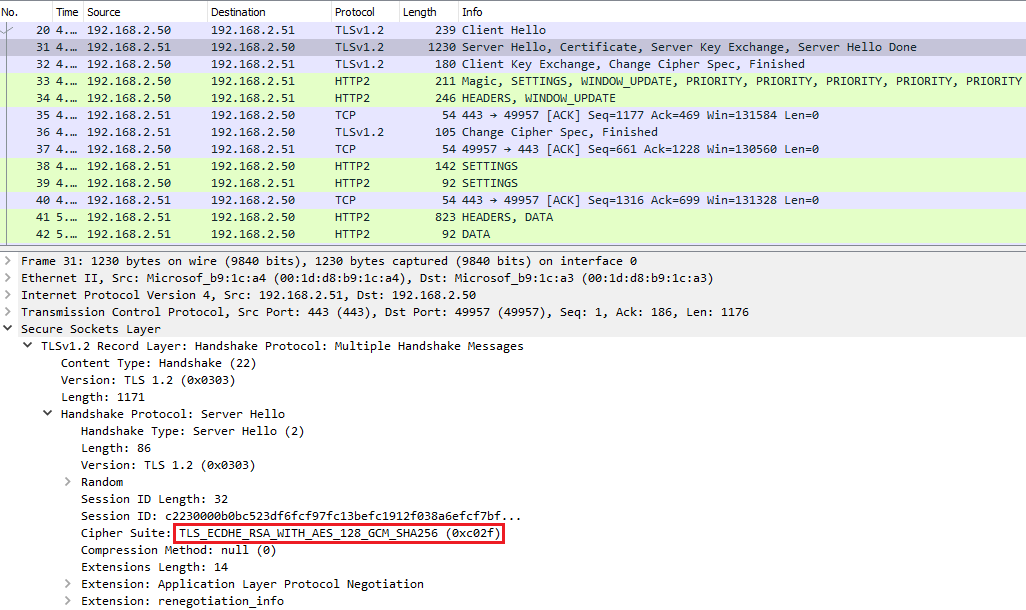

* TLSv1.3 (IN), TLS handshake, Newsession Ticket (4): * SSL certificate verify result: self signed certificate (18), continuing anyway. * SSL connection using TLSv1.3 / TLS_AES_256_GCM_SHA384 * TLSv1.3 (OUT), TLS handshake, Finished (20): * TLSv1.3 (OUT), TLS change cipher, Change cipher spec (1): * TLSv1.3 (IN), TLS handshake, Finished (20): * TLSv1.3 (IN), TLS handshake, CERT verify (15): * TLSv1.3 (IN), TLS handshake, Certificate (11): * TLSv1.3 (IN), TLS handshake, Encrypted Extensions (8): * TLSv1.3 (IN), TLS handshake, Server hello (2): * TLSv1.3 (OUT), TLS handshake, Client hello (1): * CAfile: /etc/ssl/certs/ca-certificates.crt * successfully set certificate verify locations: Note that we now need to provide the -k flag for curl since the snake oil certificates are self-signed and are therefore not trusted: $ curl -v -k * Trying 127.0.0.1:443. We would not see any HTTP traffic at all, instead we only see a TLS handshake and encrypted data packets. With TLS encrypted connections this is not as simple anymore. We can clearly see the HTTP request we just performed with curl. Stop tcpdump and look at the packet capture with tshark: # -r dump.pcap - Read packet data from infile * Connection #0 to host localhost left intact

In yet another terminal, run the curl command to perform a plaintext request to the container: $ curl -v * Trying 127.0.0.1:80. Sudo tcpdump -v -i any "src localhost || dst localhost" -w dump.pcap # -w dump.pcap - Write the raw packets to file rather than parsing and printing them out. # "host localhost" - Filter for all packets related to localhost In a separate terminal, run tcpdump to capture traffic: # -v - When parsing and printing, produce (slightly more) verbose output. # simple-apache-httpd - The IMAGE which starts the processĭocker run -it -rm -net="host" -name simple-apache-httpd simple-apache-httpd # -name simple-apache-httpd - Assign a name to the container # -net="host" - Connect a container to a network # -rm - Automatically remove the container when it exits Now, run the Apache httpd server as a container: # -i - Keep STDIN open even if not attached. Then build it with this command: docker build -t simple-apache-httpd.

e 's|^\(SSLCertificateKeyFile\).*|\1 /etc/ssl/private/ssl-cert-snakeoil.key|' \ e 's|^\(SSLCertificateFile\).*|\1 /etc/ssl/certs/ssl-cert-snakeoil.pem|' \ # enable https on port 443 with snakeoil certificates Since they are self-signed, they will not be recognized as trusted certificates by most user-agents but that is not a problem here. These are self-signed certificates that can be used for testing. Additionally, we enable TLS encrypted connections on port 443 and for that we use the snake oil certificates provided by the ssl-cert package. This sets up an Apache httpd webserver that accepts plain-text connections on port 80 by default. To run the Apache httpd container, create a file called Dockerfile with the following contents.
#WIRESHARK DECRYPT TLS 1.2 WITH PRIVATE KEY SOFTWARE#
We will run Apache httpd inside a Docker container for convenience but it would work just the same for non-containerized Apache httpd installations, whether they are installed from the distro’s software repository or self-compiled. First, we run a simple Apache httpd server that accepts plain-text connections on port 80 and TLS encrypted connections on port 443.

To start off, let us look at an example, of how we can debug HTTP traffic with tshark. The debugging shown here can of course be done using the GUI-based Wireshark as well. Tshark is the CLI-based version of Wireshark and provides more or less the same capabilities for dissecting network packets. In this case it is easy enough to use a tool like tcpdump to capture the packets and inspect them with a tool like Wireshark.įor the demonstrations below, tshark is used instead of Wireshark. This is trivial when HTTP requests are sent over an unencrypted channel. To debug HTTP requests, it may be useful to capture traffic and look at the packets that are sent back and forth between the client and the server. This entry was posted in Security and tagged apache security ssl tcpdump tls tshark wireshark on by Simon Studer


 0 kommentar(er)
0 kommentar(er)
